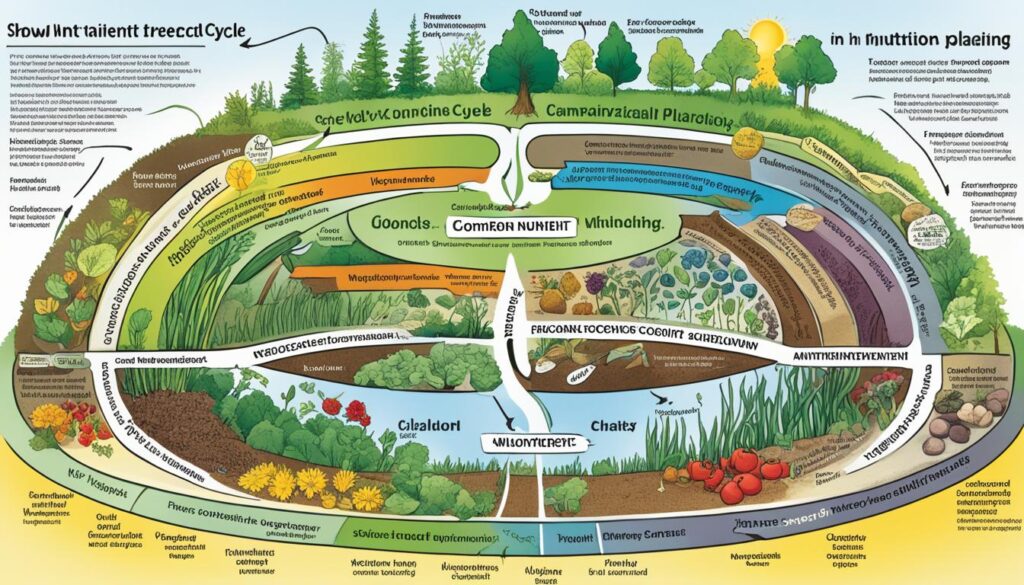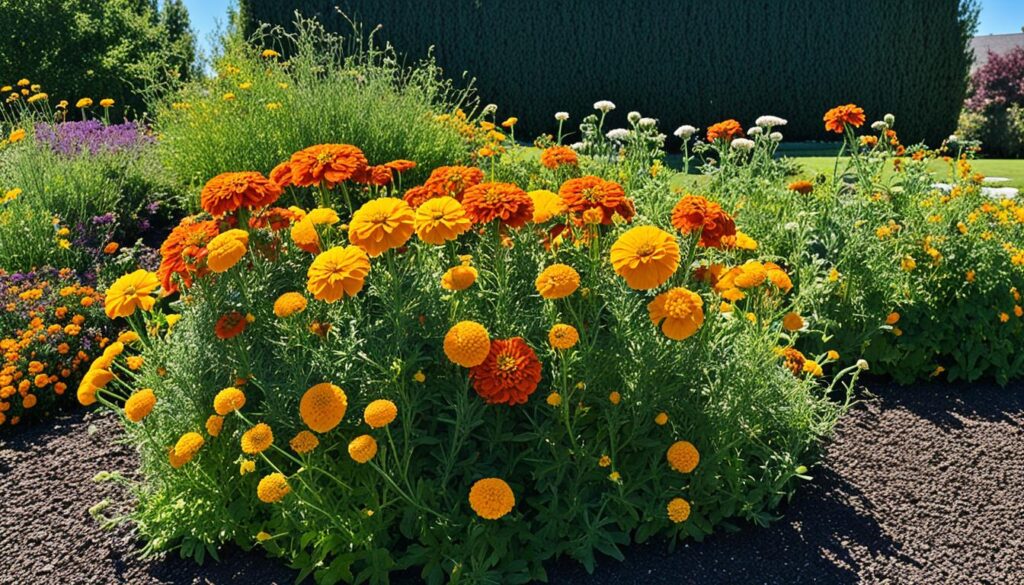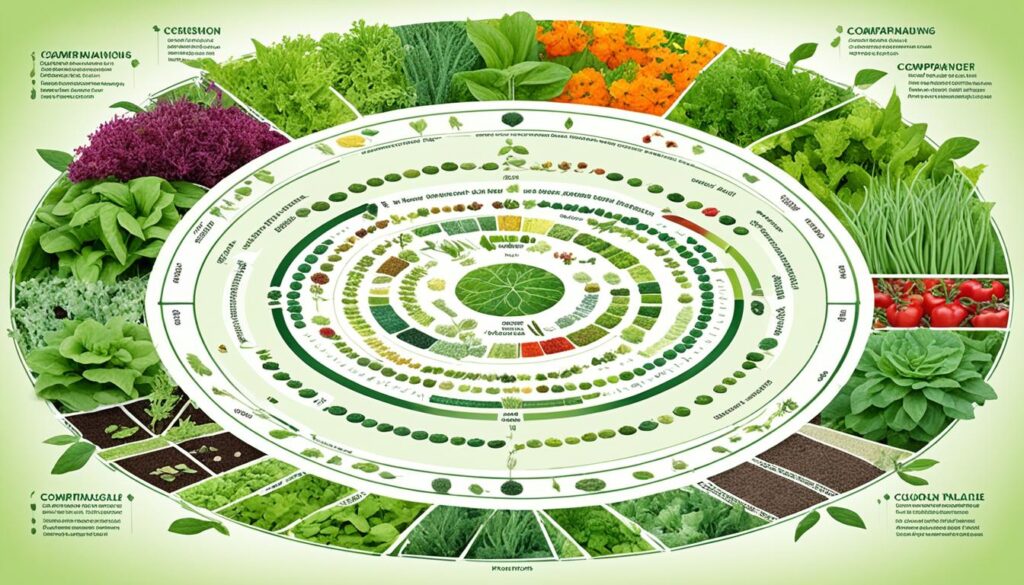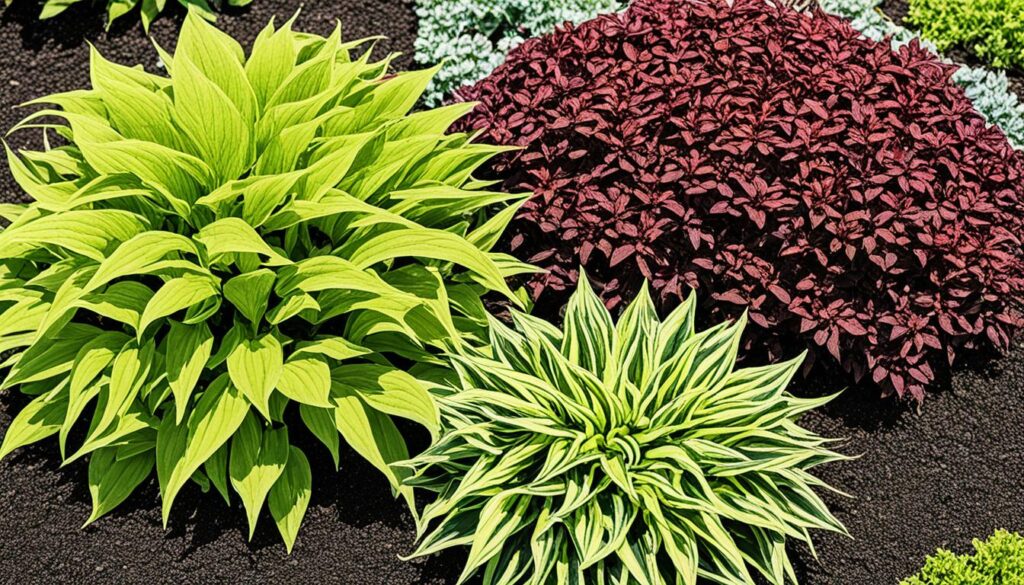I love gardening indoors and want to share a detailed guide on companion planting. It’s an ancient technique that smartly uses the power of nature. By planting certain plants together, your garden will be lively, free from pests, and full of life.1
This guide will cover what companion planting is and why it’s so great. You’ll learn how to make your indoor garden not just pretty but also healthy and full of life. This technique isn’t just for looks, it’s how you can garden in a way that’s good for the Earth.1
It doesn’t matter if you’re new to indoor gardening or a pro, this guide is for you. By the time you finish reading, your indoor garden will be more than a hobby. It will be a beautiful, natural haven that you’ve created with care.1
Key Takeaways
- Companion planting is the strategic growing of different plants together for mutual benefit, such as pest control, nutrient sharing, and physical support.
- The concept of companion planting has been practiced for centuries by various cultures, including the Native Americans’ “Three Sisters” method.
- Companion planting offers numerous benefits, including pest prevention, improved nutrient utilization, attraction of beneficial insects, and enhanced soil health and biodiversity.
- Certain plants can deter pests through their natural compounds or by attracting predatory insects that prey on garden pests.
- Companion planting can optimize the use of soil nutrients by pairing plants with different nutrient requirements, such as deep-rooted plants bringing up nutrients for shallower-rooted plants.
What is Companion Planting?
Companion planting is when you grow different plants together to help each other out.1 The idea is to let the plants’ natural ways benefit each other. This can make the plants grow better, keep pests away, and boost the garden’s productivity. The main aim is to build a natural network where every plant plays a role in supporting the others.
Definition of Companion Planting
Companion planting is the practice of growing different plants together in a garden or farm.1 It makes use of plants’ natural interactions to support growth, keep pests at bay, and improve productivity. The key idea is to form a complex ecosystem in which every plant has a job to do for the others.
Historical Background
For centuries, cultures worldwide have known about and used companion planting.2 Native Americans, for instance, mixed corn, beans, and squash in what they termed the “Three Sisters” method. All three plants help each other grow and stay healthy.2 In Asia, rice fields often have fish ponds nearby. This is another form of companion planting, creating a harmonious environment.2 And even the ancient Egyptians realized that some plants grow better next to certain others, thus improving soil and crop yield.
Benefits of Companion Planting
Companion planting comes with many advantages for the garden or farm.12
- Pest prevention: Some plants naturally repel pests or attract insects that eat them.1
- Improved nutrient utilization: Certain plants can add important nutrients to the soil. This helps other plants nearby.1
- Attracting beneficial insects: Certain companion plants attract bees and other beneficial insects. This helps keep pest numbers down.2
- Providing natural shade and support: Taller plants can give shade and physical support to their smaller neighbors.1
- Enhancing soil health: Having a variety of plants can make the soil healthier, cut down on weeds, and boost its fertility.2
- Increasing biodiversity: By mixing plants, you encourage a wide array of life in your garden. This makes the area more resilient and balanced.12
Biological Mechanisms of Companion Planting
Doing companion planting helps to use soil nutrients better.3 It pairs plants that need different nutrients together. For instance, deep-rooted plants draw up nutrients from the soil depth. This benefits plants with shallower roots. Legumes, like beans, enrich soil by adding nitrogen. This helps nearby plants needing more nitrogen.3
Nutrient Sharing
Plants can share nutrients which is vital in companion planting.3 By planting different plants close to each other, the soil gets richer. This boosts the garden’s health.3
Pest Control
Some plants naturally keep pests away or attract helpful bugs.3 Marigolds stop nematodes with chemicals from their roots. Mint and basil’s strong smells deter many insects.3 Mixing plants creates a natural barrier against pests.
Pollination Support
Flowering plants bring in bees, butterflies, and birds to pollinate the garden.3 This leads to more and better crops.
Physical Support
Companion plants can also physically support each other.3 Taller plants provide a frame for climbers. Big plants offer shade, helping certain others. This moderates soil conditions.
Allelopathy
Allelopathy is about how some plants’s chemicals can help or stop others from growing.3 In companion planting, some plants make substances that keep pests away or control weeds. Others boost the growth of nearby plants.
The benefits of companion planting, like nutrient sharing, pest control, pollination, and more, show why this method works.3 Knowing how these processes work is key to a great garden. It makes for a strong, healthy ecosystem.

Companion Planting for Vegetables
Tomatoes
Tomatoes love having basil nearby. Basil can keep thrips away and make moths think twice about laying eggs. These moths are the ones that become tomato hornworms. Planting marigolds around tomatoes helps fight off nematodes, another tomato enemy.
Carrots
Pairing carrots with onions is smart. Onions can ward off carrot flies.4 Also, adding radishes helps protect carrots. Radishes grow fast and make the carrot rows visible. This also helps keep pests away.4
Lettuce
Lettuce likes being grown under big plants like tomatoes or corn. They provide the shade the lettuce needs. This prevents the lettuce from getting sunburned.4
Peppers
Peppers do well with onions, spinach, and tomatoes. Onions chase pests away. Spinach and tomatoes add nutrients and give peppers a little support.4
Beans
Beans and corn make a great team. Corn lets beans climb on it.4 Also, planting marigolds next to beans guards them against pests.5
Companion Planting with Flowers
Flowers offer more than beauty in the garden. Marigolds, nasturtiums, sunflowers, and lavender are among the top choices for this.
Marigolds
Marigolds are top companion plants for veggies. They keep off pests like nematodes, aphids, and some beetles. When placed near tomatoes, onions, and carrots, they shield these plants from harm. Marigolds’ fragrance helps protect these crops.6
Nasturtiums
For cucumbers, squash, and similar veggies, nasturtiums work wonders. They divert pests like aphids and squash bugs. Acting as a decoy, they protect the main crops. Planting nasturtiums does this trick.6
Sunflowers
Sunflowers draw in important pollinators like bees and butterflies. Plus, their tall stalks offer natural support for plants such as cucumbers. They also provide shade for these plants. Sunflowers and their traits benefit the garden.6
Lavender
Lavender’s strong scent keeps pests like deer and rabbits at bay. By placing lavender at the garden’s edges or in between plants, many insects stay away. Lavender’s smell protects the garden.6

Herbs as Companion Plants
Herbs make great companions in the garden thanks to their scents. Rosemary, thyme, and mint keep bugs away7. On the other hand, dill and borage bring in insects that eat pests, aiding in Pest Control.7 Mixing various herbs in your garden creates a balanced environment. This helps prevent pests and attracts pollinators Pollinator Attraction.7
For specific plants, basil is a good match with tomatoes and peppers for keeping pests away. This includes whiteflies and aphids7. Chives help protect carrots and tomatoes by repelling harmful bugs. They keep away aphids, beetles, and other pests.7 Dill serves tomatoes and peppers well, countering pests like aphids.7 Oregano, a versatile herb, supports almost all vegetables against aphids. It’s especially helpful for peppers, squash, and strawberries7.
Rosemary, well-suited for beans and cabbage, keeps pests like moths at bay.7 Thyme, when near cabbage and strawberries, helps keep cabbageworms and maggots away7. Garlic, if planted close to roses and raspberries, wards off certain pests.7 Lavender can protect cabbage and attract pollinators at the same time. It discourages moths on apple trees7.
Lovage can be placed sporadically to enhance the growth of nearby plants.7 Summer Savory is a favored herb for enhancing the taste of various dishes. This includes soups, stews, and paired with meat and vegetables.7
Companion Planting Guide
Plant Companion Chart
The companion planting chart lists plant friends in the garden.4 It shows which plants help each other, like giving pest control or sharing nutrients.1 Using this guide helps make a garden where plants support one another. This leads to healthier plants, fewer pests, and more crops.
Incompatible Plant Combinations
Some plants just don’t get along well, even in the garden.4 For instance, tomatoes and potatoes together can cause diseases. Pairs like beans and onions or carrots with parsnips can slow each other down or bring more bugs. Knowing what not to plant together is key for a successful garden.

Soil Health and Crop Rotation
To have a successful garden, ensuring the soil is healthy is a must. This calls for regular actions like composting, mulching, and crop rotation. These tasks can boost the soil’s quality, fertility, and the number of living organisms in it.8
Moving crops to different spots each year is key. It stops the soil from losing important nutrients. Also, it helps control pests and diseases naturally. This approach makes the garden a welcoming place for plants to help each other grow.
Legumes, including peas and beans, are great for the soil. They fix nitrogen, which is good for other plants nearby. With the right crop rotation, this boosts the soil’s quality and its nutrient balance.8
Shifting crops is especially important for cabbage family plants. They need soil with a specific acidity. By doing this, gardeners keep the soil just right for these plants to grow strong and healthy.
| Vegetable Family | Examples |
|---|---|
| Cabbage | Rutabaga, turnips, kohlrabi, cauliflower, etc. |
| Pea & Bean | Peas, beans, soybeans, peanuts |
| Onion | Onions, garlic, leeks, etc. |
| Tomato & Potato | Potatoes, tomatoes, eggplant |
| Carrot & Dill | Carrots, beets, radish, etc. |
| Squash & Marrow | Squash, cucumber, melon, pumpkins |
| Beet | Beet, spinach, Swiss chard |
Knowing what each vegetable group needs helps in making a solid crop rotation plan. This keeps the soil rich and life in the garden happy.8
“Biodiversity is key to a healthy environment and happy plants. Companion planting increases plant resilience and nutrient uptake.”8
With a focus on the soil and smart crop rotation, gardeners set the stage for a great garden. It grows a lot of food and a strong, healthy community of plants.
Avoiding Bad Combinations
Companion planting is great, but we must know which plants not to put together. For example, garlic and onions might not let beans and peas grow well.9 Tomatoes and potatoes together can get sick more easily.9 It’s key to learn about these Antagonistic Relationships for your garden to thrive.
Science tells us about 21 bad plant matches.10 These may not deal well together because of how they grow or what they release. They might need different spaces, have different life cycles, or don’t like the same amount of water.10
Sunflowers put out a toxin that stops certain plants from growing near them.9 Beans don’t like hanging out with chives, garlic, and more because they also release a toxin.9 Peas avoid hanging with bulb veggies like chives and garlic.9 Broccoli and cabbage don’t mix well with things like peppers, squash, or tomatoes.9
Some plants just can’t stand certain soil conditions, like lavender and wet soil, or carrots and spinach.10 Mixing annuals and perennials can make weeding and caring for them harder.10
Plants have different needs when it comes to food and soil nutrients. This can lead to conflicts in the garden.10 Also, the weather and season impact which plants should be planted together.10
Some trees and plants, like black walnuts and fennel, can harm others because of substances they release.10 The way some plants grow can make it hard to pair them, like asparagus needing a lot of space.10

Importance of Biodiversity
I love gardening, and I see how important biodiversity is. It makes a garden healthy and able to take care of itself. By using all kinds of plants and flowers, I’ve seen how much more alive my garden is.11
Diverse gardens bring in lots of good bugs and keep everything in balance.11 The right mix of plants helps not-so-friendly bugs stay away. This means less trouble from pests.11
Growing different plants together has made my garden better and safer.11 Each type of plant brings friends like good bacteria and helpful bugs.11 Plus, some plants help with pests, stop weeds, and make the soil healthier.11
The way plants work together is special and helps my garden act like a little wild area.11 Thanks to mixing plants wisely, my garden doesn’t just survive; it helps the area around it too.12
FAQ
What is companion planting?
Companion planting means putting different plants close together. This is to help them both grow better. They help each other in many ways, like keeping away pests and producing more food.
What are the benefits of companion planting?
Companion planting makes gardens healthier and more diverse. It helps avoid pests, uses nutrients better, and attracts good bugs. Plus, it even makes the soil healthier.
How does companion planting work biologically?
Plants can team up in many ways. They may share nutrients, make smells that pests hate, or draw in helpful insects. It’s like a natural system that benefits all the plants together.
What are some good companion plants for vegetables?
Veggies like being near certain plants. For example, tomatoes and basil are good friends. So are carrots with onions or radishes. Plants like to be together for many reasons.
How can flowers be used as companion plants?
Flowers are not just for looks; they help the garden a lot. For instance, marigolds scare away pests. Sunflowers and some herbs like lavender bring in bees. This helps all the plants.
What herbs make good companion plants?
Herbs are great at keeping the garden healthy. Herbs like rosemary and mint can keep pests at bay. They also attract good bugs. Herbs and vegetables often make a great team.
What is a companion planting guide or chart?
A guide helps you know which plants are great together. It lists the best combos that benefit each other. This way, you can plan a garden that works well naturally.
How does soil health and crop rotation affect companion planting?
Good soil is essential for companion plants to thrive. Healthy soil boosts the plants’ ability to help each other. It’s also key to switch where you plant things to keep the soil rich and diverse.
What plant combinations should be avoided in companion planting?
While some plants love being together, others just don’t get along. For example, tomatoes and potatoes are not good partners. Some pairings can even spread diseases. It’s important to know which plants shouldn’t be near each other.
Why is biodiversity important in a companion planting system?
Biodiversity supports a balanced and fruitful garden. It mimics nature’s own harmony. This brings in helpful creatures, like bees, while keeping the garden healthy. With more life in the garden, everything grows better.
Source Links
- https://www.almanac.com/companion-planting-guide-vegetables
- https://www.marthastewart.com/8379510/companion-planting-guide
- https://www.thecelticfarm.com/what-is-companion-planting/
- https://www.thespruce.com/companion-planting-with-chart-5025124
- https://www.burpee.com/blog/companion-planting-guide.html
- https://www.learningwithexperts.com/gardening/blog/companion-planting-flowers-to-grow-with-vegetables
- https://www.almanac.com/content/companion-planting-herbs
- https://www.thegardenwebsite.com/vegetable-gardening-organic.html
- https://momsneedtoknow.com/companion-planting-plant-together/
- https://www.epicgardening.com/plant-combinations-to-avoid/
- https://www.tallahassee.com/story/life/home-garden/2021/09/23/cultivate-biodiversity-garden-companion-plants-bugs-plants-gardening/5828939001/
- https://paigepuckett.com/2012/06/20/importance-of-interplanting-and/
